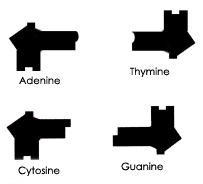Exploration
Objective:
Students will describe the structure of the double helix, explain how DNA copies
itself, recognize that the sequence of DNA is what makes each individual unique,
and recognize that similarities in the sequence of DNA indicate relationships
and similarities between species.
Materials Needed:
For each student:
- Crayons or Markers
- Scissors
- Tape
- Paper
- Two copies of nucleotide pairs
shown here

Focus Activity:
Divide students into pairs. Write the
following sentences on the board:
- Each cell's DNA would be six
feet long if spread out.
- Your DNA is 99.9% the same as
the person sitting next to you.
- Your DNA is 90% the same as a
mouse.
- Your DNA is 60% the same as a
fruit fly.
Have students decide and provide reason why
each of the statements is true or false. (All are true.)
Lesson Steps:
- Tell students all statements
are true. Ask what it is about DNA that makes them 99.9% similar to other
humans. Have students contribute their own ideas, then lead them to the idea
that the structure and sequence of DNA makes you unique. The more similar
the DNA, the more closely related the species (or individual in a species)
are evolutionarily.
- Once you have established that
the structure of DNA makes us both unique and similar to others, give
students basic information about the structure. DNA is made up of
nucleotides. Each nucleotide has three parts: five-carbon sugar (deoxyribose),
phosphate, and a nitrogen base. There are four nitrogenous bases: adenine,
thymine, cytosine, and guanine. These nucleotides join together to form two
strands, with the nitrogenous bases connecting in the middle of the two
strands. Adenine binds to thymine, cytosine to guanine. The two strands
twist around each other to form what is known as a double helix. Show
students a picture of a double helix.
- Distribute the paper
nucleotide replicas, crayons/markers, scissors, and tape to students.
Students should still be in pairs; however each person will color, cut out,
and construct his or her own model. Instruct them to color each part of the
nucleotide a specific color. That is, color all phosphates one color, all
deoxyriboses another color, all adenine another, etc. Then, instruct
students to cut out each nucleotide and piece them together like a DNA
molecule. One partner should tape his or her strands together but not tape
them in the middle. (Students should be able to open and close the DNA
strand that they build.) The other partner's model should be put together,
but not taped anywhere. Let them know that they may have to be creative to
get the helix to fit together (e.g., they may need to flip over some of the
bases to get the other strand).
- When finished, tell students
you will use their structures to model the way DNA copies itself through
replication. Have students take the model with the taped sides and separate
the two strands. (This is the first step of replication, where the DNA
molecule unzips.) Then they should use their partner's untaped nucleotides,
bringing in each nucleotide and binding it to the appropriate base. (This is
the second step of replication where free floating nucleotides come and bind
to each of the old strands.) Finally, ask students to check their two new
DNA strands to ensure they did not make any mistakes. (This is the third
step of replication, where an enzyme checks for errors.)
- When finished, have all
students tape their models to a white piece of paper to display them. Talk
about how to make strand with template and how each strand is part
"old" and part "new" and think about why that might be a
good way to copy and proofread

